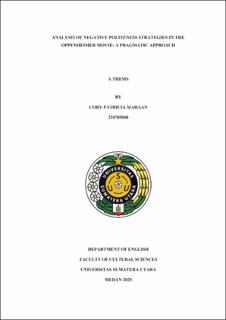Analysis of Negative Politeness Strategies in The Oppenheimer Movie: A Pragmatic Approach
Analisis Strategi Kesopanan Negatif dalam Film Oppenheimer: Pendekatan Pragmatik

Date
2025Author
Siahaan, Cory Patricia
Advisor(s)
Deliana
Rosa, Rusdi Noor
Metadata
Show full item recordAbstract
This research analyzes the use of negative politeness strategies in the Oppenheimer movie through a pragmatic approach based on Brown and Levinson’s (1987) politeness theory. The study aims to identify the strategies of negative politeness used in the film and examine the factors that influence their use. The data were taken from selected utterances in the movie that reflect face-threatening acts (FTAs) mitigated through politeness. The findings show that the most dominant strategies are question, hedge, which occurred in 15 utterances, and be conventionally indirect, which occurred in 11 utterances. These are followed by other strategies such as minimize the imposition occurred in 9 utterances, apologize occurred in 7 utterances, give deference occurred in 6 utterances, be pessimistic occurred in 4 utterances, state the FTA as a general rule occurred in 4 utterances, impersonalize speaker and hearer occurred in 3 utterances, and go on record as incurring a debt occurred in 1 utterance. These strategies are commonly used in formal, high-stakes interactions to avoid direct confrontation and preserve the hearer’s autonomy. The use of these strategies is influenced by several factors, such as payoffs occurred in 20 utterances, rank of imposition occurred in 23 utterances, social Distance occurred in 10 utterances, and relative power occurred in 7 utterances. Among these, rank of imposition emerges as the most dominant factor influencing the use of negative politeness, especially in situations involving high moral or institutional pressure.
Collections
- Undergraduate Theses [873]
